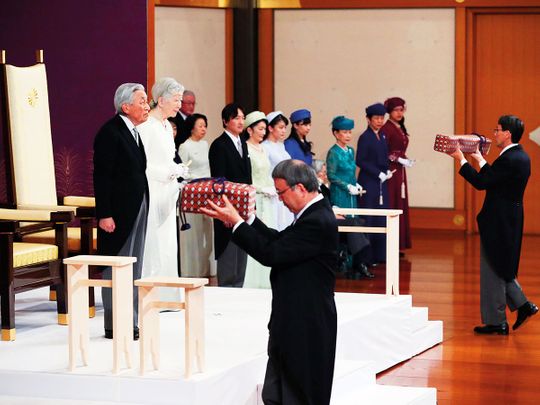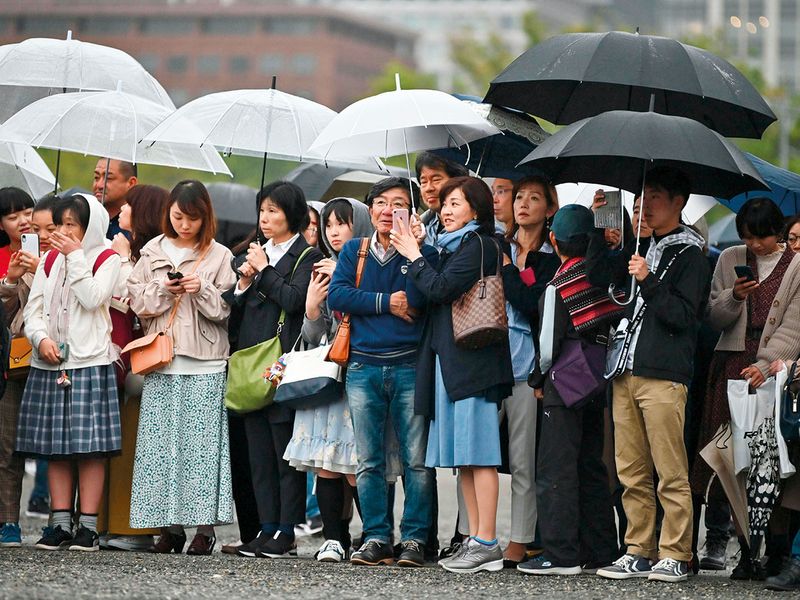
Tokyo: Three decades after he ascended the throne and three years after he asked to step down, Japan’s emperor Akihito formally stepped down on Tuesday, the first abdication for 200 years in the world’s oldest monarchy.
Akihito’s son Naruhito, 59, took the Chrysanthemum Throne and ushered in a new imperial era, as his father became the first in more than two centuries to abdicate. The last emperor to abdicate was Kokaku, in 1817.
In the ‘Room of Pine’ in Tokyo’s Imperial Palace, the popular 85-year-old performed the abdication ritual in the presence of the imperial regalia — an ancient sword and sacred jewel that are considered to legitimise an emperor.
In his final speech, Akihito offered his “deepest heart-felt gratitude to the people of Japan” and said he would “pray for the peace and happiness of all the people in Japan and around the world”. Despite near-constant rain in Tokyo, several hundred well-wishers congregated outside the Palace during the historic ceremony attended by around 300 people, including Prime Minister Shinzo Abe and around a dozen members of the royal family.

“I feel overwhelmed emotionally,” said a tearful Yayoi Iwasaki, a 50-year-old bank employee, standing outside the palace.
“In the past, enthronements followed the death of emperors and people weren’t sure whether they should be happy and celebrating, but with this transition, I am sure that we can celebrate while welcoming the new era,” she said.
1817
the last abdication of emperor KokakuUnder Naruhito, the new era of “Reiwa” — meaning “beautiful harmony” — begins, lasting for as long as he reigns.
SHOCKING NEWS
Public broadcaster NHK stunned the public in July 2016 when it reported that Akihito, then 82, intended to abdicate “in a few years”, an unprecedented step in modern Japan. Akihito, who had a heart surgery and was treated for prostate cancer, had earlier privately expressed a desire to retire and had been reducing his official duties. A month later, Akihito said in a rare video address to the nation that he worried age might make it difficult for him to carry out his duties fully.
300
people attended Akihito’s abdication ceremony despite rainAkihito was Japan’s first emperor to inherit the throne under a post-war constitution that defines the monarch as a symbol of the people without political power. He has carved out a role as an advocate of reconciliation, peace and democracy and associates say he believes only an active monarch can fulfil his true obligations.
CONSERVATIVE OBJECTIONS
Many ordinary Japanese sympathised with Akihito’s desire to step down, but the idea met opposition from Prime Minister Abe’s conservative base. Some opponents of the abdication have raised the possibility of disagreement between the old and new emperors, and they fear the next reform could allow a woman to ascend the throne. It is currently restricted by law to males only. A shortage of male heirs has led to calls to change the succession rule, but the reform is anathema to traditionalists.
SYMBOLIC FIGURE
The emperor, once regarded as a demigod, is now an entirely symbolic figure in Japan. Akihito, along with his wife, Empress Michiko, have been hugely popular among the Japanese as they have sought to bring the monarchy much closer to the people. Akihito and Michiko travelled across Japan and were a consoling presence particularly after disasters. They visited the Kobe region after the 1995 earthquake that killed close to 6,500 people, kneeling before survivors in a break with tradition.
16000
people killed in the 2011 earthquakeAfter the 2011 earthquake and tsunami that killed almost 16,000 people in northern Japan and caused a nuclear disaster, the emperor gave an unprecedented nationally televised address, asking people to act with compassion “to overcome these difficult times”.
WHY ABDICATE
When Akihito took over the throne in 1989, it was after his father had suffered a prolonged illness. Akihito, who was treated for prostate cancer in 2003 and underwent heart surgery in 2012, may have wished to avoid subjecting his son to a period of such limbo. But the decision to abdicate was not the emperor’s alone to make. It required a special act of the parliament, passed in 2017. The law applies only to him and not to future emperors.
PRECEDENT SET
After discussions among experts, parliament in June 2017 enacted a special law to allow Akihito to step down, the first abdication of an emperor in about 200 years. Although the law applies only to Akihito, it was seen by scholars and some officials as setting a precedent. After abdication, Akihito now becomes known as “joko”, or emperor emeritus and Michiko will be known as “jokogo,” or empress emerita. Akihito and Michiko will leave the Imperial Palace and stay in another imperial residence until they move into the Togu Palace, where they lived before he inherited the throne and which will be renovated for their use.








